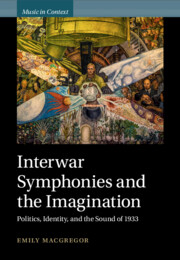Book contents
- Interwar Symphonies and the Imagination
- Music in Context
- Interwar Symphonies and the Imagination
- Copyright page
- Dedication
- Contents
- Figures
- Examples
- Preface
- Acknowledgements
- Abbreviations
- 1 Between Europe and America: Kurt Weill’s Symphony in a Suitcase
- 2 Listening for the Intimsphäre in Hans Pfitzner’s Symphony in C♯ Minor
- 3 Liberalism, Race, and the American West in Roy Harris’s Symphony 1933
- 4 Aaron Copland’s and Carlos Chávez’s Pan-American Bounding Line
- 5 Arthur Honegger’s ‘Modernised Eroica’
- 6 The Right Kind of Symphonist: Florence Price and Kurt Weill
- Select Bibliography
- Index
6 - The Right Kind of Symphonist: Florence Price and Kurt Weill
New York and Chicago 1933–4 – London 2020
Published online by Cambridge University Press: 28 January 2023
- Interwar Symphonies and the Imagination
- Music in Context
- Interwar Symphonies and the Imagination
- Copyright page
- Dedication
- Contents
- Figures
- Examples
- Preface
- Acknowledgements
- Abbreviations
- 1 Between Europe and America: Kurt Weill’s Symphony in a Suitcase
- 2 Listening for the Intimsphäre in Hans Pfitzner’s Symphony in C♯ Minor
- 3 Liberalism, Race, and the American West in Roy Harris’s Symphony 1933
- 4 Aaron Copland’s and Carlos Chávez’s Pan-American Bounding Line
- 5 Arthur Honegger’s ‘Modernised Eroica’
- 6 The Right Kind of Symphonist: Florence Price and Kurt Weill
- Select Bibliography
- Index
Summary
Alighting briefly once again on Weill’s Symphony No. 2 from the book’s opening, and then turning to consider Florence Price’s Symphony in E minor as a closing case study, Chapter 6 pivots between the early 1930s and the present day to consider the legacies and twentieth-century historiography of the symphonies in the book – their absences and recoveries – and the remarkable persistence of the symphonic genre in the mechanisms of how cultural and political agency is conferred to the present day. The poor reception of Weill’s New York premiere in 1934 comes under examination in light of the discussion in the intervening chapters, raising the question of why, for that time and place, Weill was the wrong kind of symphonist. Then, the chapter addresses the contemporary revival of Price’s symphony in the early 2020s, and it suggests the capacity of symphonies from the tumultuous years around 1933 to invigorate a differently dynamic symphonic landscape and a differently dynamic landscape of selfhood.
Keywords
- Type
- Chapter
- Information
- Interwar Symphonies and the ImaginationPolitics, Identity, and the Sound of 1933, pp. 206 - 235Publisher: Cambridge University PressPrint publication year: 2023

